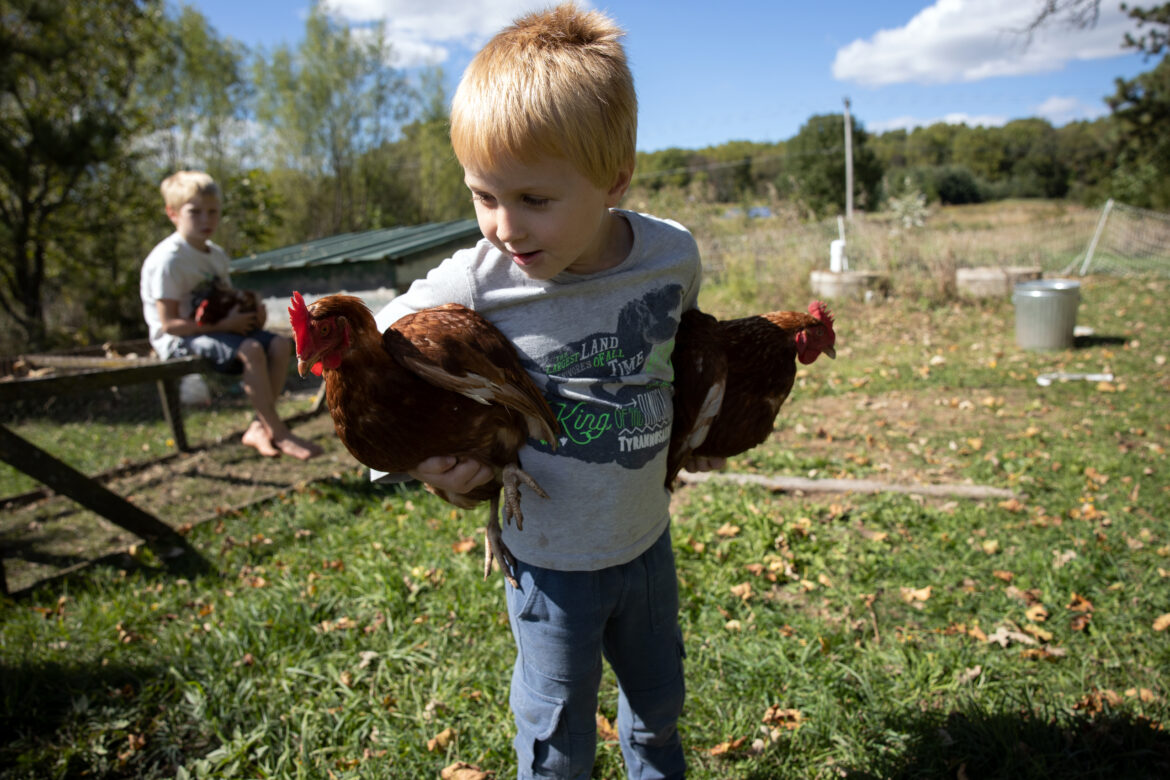By Peter Cameron, The Badger Project
For the first month of the school year, the Millar children of rural Blue Mounds, Wisconsin, stayed home.
“It wasn’t very much fun,” the oldest, 10-year-old Adara Millar, said of her virtual learning. “You’re looking at a computer screen for six and a half hours.”

To break up the screen time, their father Matt Millar took Adara and her two younger brothers Sterling and Matthias outside for “man stuff.”
He notes that description is tongue-in-cheek, but for the children it meant competitions around their yard: A foot race, a rope climb, target shooting, watermelon-seed spitting, chicken catching.
Millar and the children’s mother had the option to send them to class at the Barneveld School District, but Millar’s home has good internet, which can be unusual for rural Wisconsin. And Millar’s mother-in-law was available to supervise her grandchildren’s education.
- Download this story as a Word document
- Download the photos that accompany this story
- View the original story on WisconsinWatch.org
That made the decision to keep them safe at home — at least at first — easier. But on Thursday, the district announced that all students would attend virtually after a staff member or student tested positive for COVID-19, the second time the district has closed its school building because of a virus scare.
Millar said the case came from one of his children’s classrooms — so the family will be on a “strict, personal quarantine” for the time being.
Hundreds of schools affected
Across Wisconsin — currently one of the nation’s worst COVID-19 hotspots — health officials have investigated nearly 500 COVID-19 outbreaks in schools. More than 15,000 children ages 17 and younger have been infected to date, state Department of Health Services data show. Numerous schools across Wisconsin have suspended in-person classes this fall, at least temporarily, because of cases among students and staff.
But in Wisconsin, no child has died of COVID-19, and early research elsewhere indicates that the disease does not spread easily within school buildings.
Millar, a quantitative analyst, has gamed out various scenarios for officials on whether children should be in school. He believes a mixture of in-person and online instruction is safest and best.
“It’s a tricky decision,” Millar acknowledged.
Over in the village of Dane, 30 miles to the northeast, the Hellenbrands’ decision was made for them. The Lodi School District, where the four Hellenbrand children attend, decided to exclusively deliver instruction online at least through the first quarter, which concludes Nov. 6.
That’s really tough on the family, which has snail-like internet at their farm house. And just last week, Amy Jo Hellenbrand had to suspend her in-home day care business after she and her husband Andy both tested positive for COVID-19. She said the symptoms so far resemble a bad cold or flu, with “terrible headaches, body aches, fever, chills (and) nausea.”
Wisconsin is behind the national average when it comes to high-speed internet coverage in rural parts of the state. About 43% of rural areas lack the service, compared to about 31% nationwide.
That’s one reason Wisconsin’s rural school districts overwhelmingly decided to return to face-to-face instruction last month, said Kim Kaukl, executive director of the Wisconsin Rural Schools Alliance.
While big urban school districts like Milwaukee and Madison opted to start completely online, about 75% of the 100 rural districts that answered an optional survey from the state Department of Public Instruction planned to offer face-to-face instruction at least four days per week, a Wisconsin Watch analysis of DPI data shows. Most, if not all, give families the option of virtual schooling, however.
This is the second in a series of Wisconsin Watch stories examining how parents, students and educators in rural Wisconsin are managing this once-in-a-century crisis. For a look at how other states are faring, see Lesson plans: Rural schools grapple with COVID.
Back to school — with masks
When the Millars put their children back in school on Oct. 1, it marked the first time they had been in a classroom since March. But most rural schoolchildren in Wisconsin are in school. Or at least they started that way.
Brodhead High School suspended in-person classes for 10 days in early September after a group of students tested positive for COVID-19 from attending a party. As of Thursday, the school was operating at 50% capacity to stem the spread of the disease, which has hit at least 28 students and staff in the district and required 161 others to quarantine because of possible exposure to COVID-19.
To the frustration of some, the state is not releasing the names of the schools with outbreaks “at this time,” said Elizabeth Goodsitt, a spokeswoman for the Wisconsin Department of Health Services.
To fill the information gap, the Milwaukee Journal Sentinel and USA TODAY NETWORK-Wisconsin maintain a database of schools with positive tests based on news and public health reports. It lists nearly 800 positive tests in individual schools since the academic year began.
Goodsitt said when there is an outbreak, the state notifies anyone who was “exposed” — which means considered to be within close distance for more than 15 minutes.
Nationally, schools returning to session do not seem to have triggered many mass outbreaks, as some had feared. The vast majority of young children do not get very sick from the virus, and evidence is growing that they are less likely to contract COVID-19 than adults, according to a group of researchers and public health officials who run the website Covid-Explained. Less clear is how likely children are to spread it.
Yet as children went back to school, Wisconsin did see a surge in infections among those ages 17 and under, DHS figures show. In response to such troubling numbers, Gov. Tony Evers last month extended the statewide mask mandate another 60 days to Nov. 21.
Amy Lund is a social studies teacher at the tiny La Farge High School in western Wisconsin. With a population of 65 students, the school decided initially to offer primarily in-person instruction. Ten students elected to attend classes virtually.
But because of rising case numbers in Vernon County, the school district moved all of its 6th-12th grade education online for the first two weeks of October. On Monday, the district enacted a new model for the middle and high schools: in-person classes on Tuesdays and Fridays only, with “live, teacher-led” online classes the other three days.
Lund said schools have integrated mandatory face coverings and distancing into student life. She wears a purple and white gaiter with the school’s wildcat mascot printed on the front. Other students have matched masks to their outfits, incorporating them as accessories.
But as everyone knows by now, wearing even the most comfortable mask can get a little stuffy. To counter this, Lund says she takes occasional outdoor “mask breaks” with her students. The students are told to socially distance, but it gives everyone a fresh-air breather.
Beaming in — ‘Brady Bunch’ style
Schools have had to adjust to the shifting landscape as the pandemic has surged and retreated and now surged again. Districts face dueling political and popular sentiment that pressure them to reopen schools — or keep them closed.
Steve Elliot, the president of the Albany School Board and a father of three students in the district, feared this school year would be marked by “whipsawing” — and he has been proven correct. The second week of school, the Albany district saw its first positive test and decided to go virtual for a week. Then staffing shortages forced suspension of classes for seven days.
He says teachers have had to figure out how to switch from in-person to online classes on the fly.
“I think we’re getting better every week,” Elliot said.
Unlike many rural districts, Albany, in south-central Wisconsin, brought back only its younger students, starting with online only schooling for students in grades 7 and up. On Oct. 5, freshmen returned to full in-person instruction, but students in grades 10-12 now go to school in shifts just two days a week.
According to the Department of Public Instruction survey, most, if not all, Wisconsin districts are offering virtual instruction for students and families who choose it. That means many teachers need to tend to both students sitting in their classes and those learning from home.
“Speaking as a parent and as a school board member, it creates a very high burden on our staff,” Elliot said.
In La Farge, Lund mixes the virtual students with her live classes. At the beginning of the period, she beams the virtual students up on the digital chalkboard, “Brady Bunch” style, and lets them say “hey” to their classmates before moving to that day’s lesson. She then shares her computer screen both to the board and with the students working from home on their laptops or tablets, so everyone can see her slides and hear her lecture.
An early attempt at breaking into smaller work groups was unsuccessful due to gaps in the technology, she said.
“We lived and learned and we don’t do groups like that anymore,” Lund said. “There have been some technological errors and mistakes and learning lessons that we’re working our way through.”
Everyone — administrators, teachers, parents and students — knows that COVID-19 tests will return positive this school year, and they remain on standby to return to virtual instruction at any moment. Already, many are grappling with ensuring students who are exposed are quarantined and those who are sick are isolated, which also can disrupt learning.
In far northern Wisconsin, the Hurley School District had no cases for the first five weeks, but got its first in mid-October, leading to the quarantining of three students, but no shutdown — yet.
Attentions drifts as students stay home
When schools shuttered in March with very little notice, teachers could not keep all students focused, several educators said.
For some, that problem continues. Kevin Genisot, the superintendent of the Hurley School District, compares the distracted attitude of students learning online to students at the end of every school year.
“For some kids right now, it feels like the end of May,” he said. “We definitely struggle with that.”
Gensiot fears that the ability for students to opt into virtual schooling with no questions asked during the pandemic can lead to students making a choice that’s not in their best interest. That can lead to poor academic outcomes for some.
“We’ve lost control,” said Gensiot, who noted the district cannot overrule families’ health concerns. “And once (those students) are out of here for a year, we’re not going to get them back.”
He added: “There’s nothing that beats being in person for school. It’s much more than academics. It’s social behavior. It’s social norms. It’s learning to handle adversity. It’s the real life experiences that teach you to deal with that.”
Nobody needs to convince the Hellenbrands of that. Already balancing her day care business — now temporarily shuttered — and running a household, Amy Jo Hellenbrand must supervise her own children’s virtual education. That is especially true of her youngest, Louis, a 5-year-old kindergartener who works at the kitchen table.
Hellenbrand says when she was laid up in bed, the children had to do schoolwork on their own.
“The girls were really helpful with Louis on Thursday, because I wasn’t able to function at all,” she said.
Still coughing, Hellenbrand was back on her feet by Friday supervising Louis.
“He wants to be up and moving around and doesn’t understand why he can’t be in the combine with Dad,” said Hellenbrand, referring to her husband’s harvest of the corn crop.
The school district gave the family a hotspot, a hockey puck-shaped device that delivers Wi-Fi through a cell phone network. That has helped them balance education with their sluggish internet service, Hellenbrand said. But data caps slow the Hellenbrand’s internet at the end of a billing cycle to a crawl, like wading through waist-high snow.
She describes the monthly slowdowns as “horrible.”
Return to class — then back home
Back in Blue Mounds, Millar was relieved his children were in school again. He says his younger two — ages 5 and 7 — weren’t getting the benefits of virtual instruction.
Millar is working with school administrators and has developed a model to help them make decisions during the pandemic.
“If I could make one plug, my plug would be to go with the cohort system,” he said, referring to the method in which schools break their students into two groups, and each attends school in the building for two days a week.
“I think you get 80% of the benefit of in-person (instruction) and 80% of the safety of virtual (instruction),” he said.
But that is not the plan for his children’s school. As of Friday, the Millar children and other Barneveld students are learning from home in what the district calls a “temporary” move.
Millar says the short-term shutdown is smart, because it should allow the school to “neuter” any spread. And he says he can handle another few days of his children at home, as long as they go back to school soon.
“As parents, we’re used to the kids being home,” Millar said. “There’s in-service days, there’s parent-teacher conference days, there’s snow days, there’s kids-getting-sick days. It’s not like we’re incapable of dealing with kids being home from school.
“It just can’t be every single frickin’ day.”
This piece is part of a collaborative reporting project called Lesson Plans: Rural schools grapple with COVID with the Institute for Nonprofit News and several member newsrooms. The collaboration was made possible by a grant from the Walton Family Foundation. The nonprofit Wisconsin Watch (wisconsinwatch.org) collaborates with WPR, PBS Wisconsin, other news media and the University of Wisconsin-Madison School of Journalism and Mass Communication. All works created, published, posted or disseminated by Wisconsin Watch do not necessarily reflect the views or opinions of UW-Madison or any of its affiliates.



